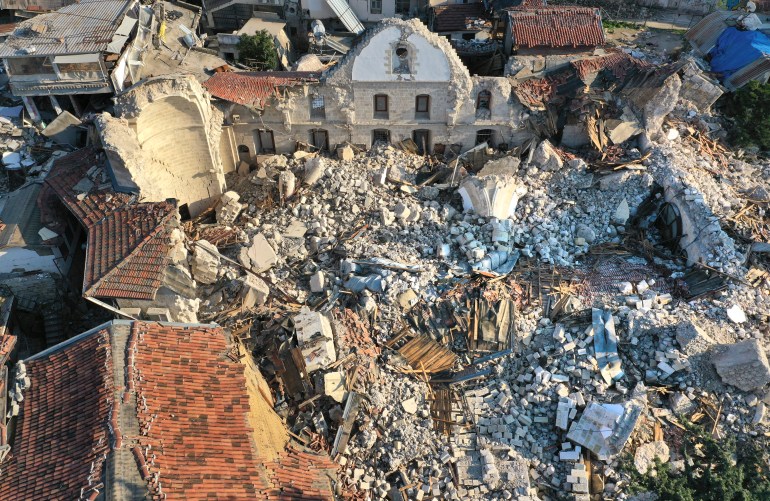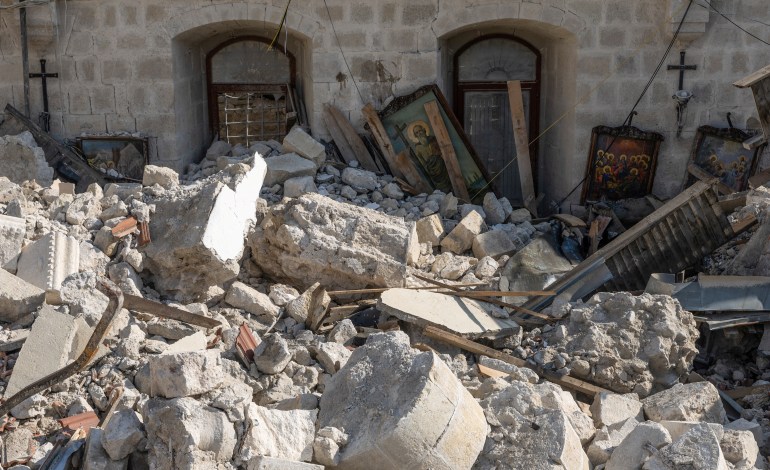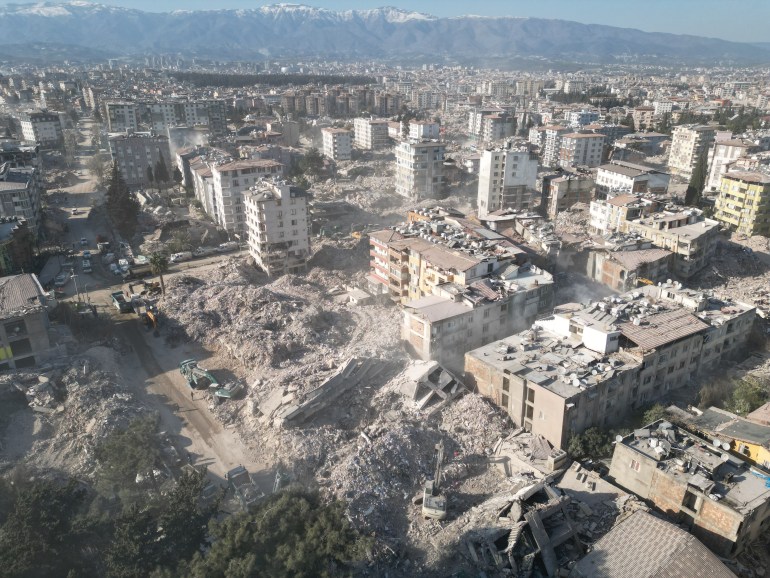His route would often take him past other churches, mosques and a synagogue, too. Church bells mingled with the call to prayer, and the streets of the ancient city resounded with different languages – all serving as a timeless reminder of its vibrant cultural diversity.
“It was really unique and had a different atmosphere than other cities in Anatolia or Turkey,” Sivri, an Arab Alevi, told Al Jazeera. “It is known as a ‘city of peace’. So many friends of mine were from different ethnic, ideological and religious backgrounds.”
On February 6, two powerful earthquakes devastated swaths of southern Turkey and northwest Syria, killing more than 50,000 people and destroying tens of thousands of buildings.
Antakya, historically known as Antioch, was particularly hard-hit.
![This mosque is actually a former Byzantine church, transformed into a mosque in the 13th century. "Habib" means "beloved" and "neccar" means "carpenter." Habib-i Neccar was killed by pagans while he was trying to protect two messengers sent to Antioch by Prophet Jesus.[Getty Images]](https://www.aljazeera.com/wp-content/uploads/2023/03/GettyImages-471200771.jpg?w=725&resize=725%2C482)

Sivri, now a 33-year-old freelance journalist living in the Turkish capital, Ankara, reached the Old City on the evening of February 6 and found much of it in ruins.
The minaret and dome of the centuries-old Habibi-i Neccar Mosque was a pile of rubble; the Greek Orthodox Church of Antioch had collapsed, thrusting its belfry into a neighbouring building and killing a resident; the city’s synagogue was scored by fissures; and the Protestant church was also in ruins.
“When I saw these buildings had collapsed, it made me feel like a part of my memories and my world had collapsed with them,” Sivri said.
In the following days and weeks, as rescue efforts ended, the Old City was largely abandoned. Those who remained were forced to pick precarious paths over mountains of rubble that blocked the narrow streets.
On the Sunday after the earthquake, about 10 members of the Protestant congregation gathered in front the rubble of their church to pray and sing hymns. They were still in shock.
Corc Kocamahhul said the building was about a century old and it had been used as a church since the year 2000.
“We never expected it could collapse, but unfortunately Antakya has disappeared and so has our church,” he said, becoming tearful as he talked about the city’s plight. “I hope we build this church again as soon as possible.”
But while the Turkish authorities say the restoration of Antakya’s historic buildings will start imminently, some are cautioning against a rush to rebuild the city’s heritage and warn that its distinctive character and communities are at risk of being lost forever.
‘We should take care of people first’
Antioch was built by the Orontes River in 300 BC by Seleucus I Nicator, a leading general of Alexander the Great and the founder of the Seleucid Empire, who named it Antioch.
It quickly found prosperity as a key trading hub along the routes linking the Mediterranean to Asia.
In 64 BC, the strategically located city was seized by the Romans and went on to become one of their empire’s most important cities. Over the centuries, it was also ruled by the Byzantines, the Arab Rashidun Caliphate, the Seljuks, the Crusaders, the Mamluks and the Ottomans.
Antioch was also an early centre of Christianity; it was here that the disciples of Jesus Christ were first called “Christians”.


After World War I, the city and its province of Hatay fell under a French mandate and became the short-lived Hatay State in 1938. Hatay only joined Turkey the following year, 16 years after the formation of the modern Turkish Republic.
Many Christians and other minorities left Antakya in 1939. The demographics of the city changed significantly in the following decades as Christian and Jewish populations further dwindled and Syrian refugees began arriving from 2012. Still, Antakya, home to some 200,000 people, retained more ethnic and religious diversity than most other parts of Turkey.
Throughout its history, the city has been destroyed and rebuilt several times due to earthquakes and conflict. Little remains of the city’s Hellenistic period. The Habibi-i Neccar Mosque, previously a pagan temple and a church, was destroyed by an earthquake in 1853 and rebuilt by the Ottomans.
The tremors in early February killed an estimated 20,000 people in Hatay, according to its metropolitan mayor, and most of the province’s buildings either collapsed or were severely damaged.
Many non-religious landmarks were also destroyed or damaged, including the old bazaar, the Affan coffee house dating back to the 1910s, and the 1927 building used as a parliament for the Hatay State.
![City of Antakya (Hatay), Turkey - stock photo Aerial view of the city of Antakya, also called Hatay, in southern Turkey. In ancient times the city was known as Antioch. The Orontes River flows through the middle of the city. [Getty Images]](https://www.aljazeera.com/wp-content/uploads/2023/03/GettyImages-1652116271.jpg?w=724&resize=724%2C483)

The government, which faces presidential and parliamentary elections in May, is keen to push ahead with reconstruction efforts.
Yahya Coşkun, deputy general director of cultural heritage and museums at Turkey’s culture and tourism ministry, told Al Jazeera that a damage assessment had almost been finished in Antakya and that the crucial pieces of the historic buildings were being salvaged.
He said that a restoration process, led by the ministry and conducted in cooperation with academic experts and national and international cultural agencies, will begin in March.
“The priority will be given to built public heritage including monuments, mosques, churches, historical houses … then the privately owned heritage will be managed,” he said.
“We have plans and reliefs of most of the historical buildings. These buildings will be restored in accordance with [the] original plans and the original materials will be used as much as possible.”
Emre Can Dağlıoğlu, an editor at the platform Nehna, a collective of Arabic-speaking Orthodox Christians in Antakya, told Al Jazeera that – while health, hygiene and accommodation needs must be tackled urgently – the rebuilding of the city’s heritage should be considered carefully before major reconstruction starts.
“It should be undertaken collectively, not only by the government from the top down but from all sectors and local organisations and associations and individuals, to think about how we should rebuild the city from scratch,” he said.
Some communities are at risk of total erasure. The city’s Jewish community, perhaps numbering fewer than 20 people, lost its leader and his wife in the earthquake.
Dağlıoğlu said that people displaced by the earthquake needed to be helped to return to Antakya to restore its diversity along with the buildings. He said he feared the city, where there is significant opposition to the government, could be gentrified or socially engineered.
“What makes Antakya beautiful is its distinctive social fabric, its social coherence, its diverse population, and we should find a way to return these people – Jews, Armenians, Alevis, Orthodox Christians, Turks, Kurds, Syrian refugees – to the city,” he said.
“We should take care of people first, because it is really meaningless to rebuild all these religious sites without their people.”
Tufan Kaya, a member of Koruma Akademisi, a Turkish NGO which studies and advises on heritage conservation, said that while some restoration projects in Turkey have won international prizes, the country’s record is generally poor.
He said restoration is often marred by cheap tenders awarded to construction companies without heritage expertise that use new materials and building techniques which are not always aesthetically pleasing or as structurally sound. Contracts are handed out in a system based on patronage, whatever the political party, he added.
“Restoration is totally different from other parts [of the construction industry]. It’s not a business, it shouldn’t be done by tenders given to whoever pays the cheapest price – if you make the restoration that way, the results will be terrible,” Kaya said.

Many believe the landmarks could also have been better protected in the first place.
Despite its beauty, much of Antakya was blighted by many of the same issues found in cities across Turkey such as haphazard urban planning, mind-numbing identikit complexes, and a proliferation of cheap and ugly buildings – many of which could not withstand earthquakes because building codes were not enforced.
Kaya said that historical buildings in the city were also subject to the same poor enforcement of building codes when renovated.
“Turkey’s regulations are perfect on paper,” Kaya said. “But, practically, people don’t apply them.”
Coşkun pointed to the lack of significant damage to Antakya’s major museums as evidence that the ministry had learned from previous disasters and was able to construct buildings that could withstand powerful earthquakes.
“I do not believe that we would require new laws for the protection of historical buildings [but] vigilant implementation of these existing tools remains the most important point,” he said.
‘Lost everything but its hope’
Those from Antakya or with a strong bond to the city draw strength from its long history of renewal.
“I believe that Antakya has really lost everything but its hope,” Dağlıoğlu said.
New civil initiatives concerned with rebuilding the city are springing up. Nehna is working with local organisations to draft a policy document to be sent to the authorities. The civil platform Antakya Yeniden (Antakya Again) aims to bring together academics, architects, archaeologists and artists.
Kaya said local people should also have a say in how the buildings are reconstructed to preserve their identity.
“The kind of information that should be inherited from the past should not be decided by bureaucrats from Ankara, you should get local people involved,” he said. “Otherwise, then they just build some tourist trap that doesn’t tell the real story of the building.”
Hakan Mertcan, an academic at the University of Bayreuth, Germany, has written and edited several books on Antakya, including Asi Gülüşlüm (which roughly translates to My Darling with a Rebellious Smile).
Asi (rebellious) is also the Turkish name for the city’s river, and the title references the inhabitants’ welcoming and good-natured spirit, along with their historical resistance to attempts at assimilation or social engineering.
“We cannot just trust the government’s efforts,” he said. “They have to rebuild the city, but with civil society, the opposition, ecologists, feminists, leftists, and with international organisations.”
Sivri also said the city must be rebuilt in a way that returns its earthquake-displaced populace and restores the largely peaceful, harmonious atmosphere alongside the beauty of its historic buildings and monuments.
“If we can go back and rebuild the city again [like this], then we can again call it Antakya,” he said.
